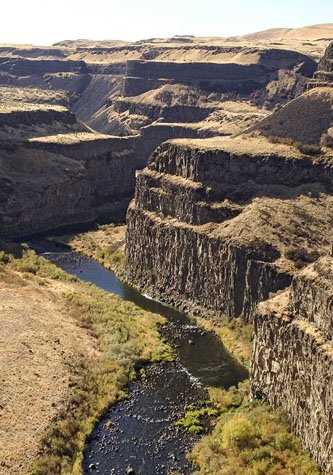A waning gibbous moon rides high in the western sky as earliest dawn breaks breezy and clear. Dark basalt cliffs loom on either side of the Snake River as the sturdy National Geographic Sea Bird nears the lock at Little Goose Dam. After a short wait we are given the green light and Captain Kay eases our ship into the lock. Our able deckhands toss a line over the floating bollard and make it fast. This line will keep the ship snug against the lock wall for our transit. The water drains from the lock by gravity and soon we have dropped a hundred feet to the level of the river below the dam. The great barn-door gate swings slowly open and away we sail, bound for the mouth of the Palouse River. On the way to our anchorage on the Palouse we are astonished to see a Mule Deer doe swimming across our bow, her head and large ears held high. Captain Kay slows the ship and the determined doe swims steadily to the far side of the river. Meanwhile, the rising sun burns golden on the buff-colored grasses of autumn and dark basalt cliffs cast angular shadows on the hills.
Soon we are anchoring in the lower reaches of the Palouse River and preparing for a morning of adventure. The expedition landing craft are lowered along with a flotilla of yellow kayaks. The kayaks are towed to shore and followed by those who have chosen to go kayaking. Others arrive onshore and board a yellow school bus for the drive overland to Palouse Falls while the third group boards the expedition landing craft for a cruise up the Palouse River.
Kayakers paddle off onto the wind-rippled water, some heading for the base of a basalt cliff and at least one is seen near the weathered brown rock! The trip to Palouse Falls is over the part of the Columbia Plateau that was ravaged by the great Ice Age floods and the damage by the raging waters is easily seen in this area of the Channeled Scablands where the cover of loess has been stripped down to bed rock. At the falls the history and geology is explained by our historian, Don. National Geographic photographer Rich Reid gives tips on photographing the falls as the water of the Palouse River plunges over the precipice, falling nearly 200 feet into its green plunge pool and flows down the flood-cut canyon below. Downstream in that canyon others are exploring the lower reaches of the Palouse. There we make our way upstream in the expedition landing craft, taking time to look at beaver lodges, cattails, western grebes, mud houses of cliff swallows, bufflehead ducks, bald and golden eagles, black-billed magpies, and more. Magnificent cliffs rise on either side of the river and look perfectly beautiful with their columns and entablatures trimmed out with the autumn grasses and scattered crimson sumac bushes. Gorgeous clouds in thin streaks stream upward over the cliff tops.
Back on our ship, as we sail on down the Snake River we enjoy a leisurely and sunny lunch on the aft deck. It is a lovely afternoon and many spend hours on deck enjoying the scenery and watching as we pass through two more locks. Rich gives an exciting presentation on how to use the camera on our iPhones. At sunset we arrive at the confluence of the Snake and Columbia Rivers and sail onto the Great River of the West. Our evening is completed with a presentation by Don on the trials of Lewis and Clark and their Corps of Discovery as they were nearing the Pacific Ocean.









